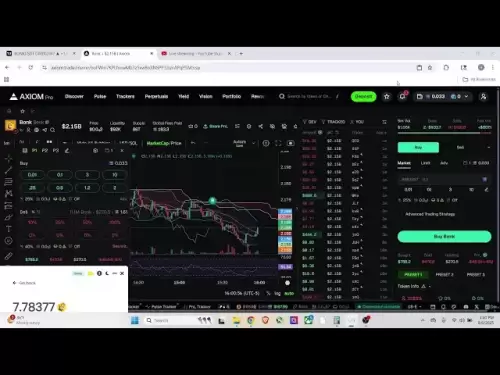-
 Bitcoin
Bitcoin $115100
1.27% -
 Ethereum
Ethereum $3675
2.71% -
 XRP
XRP $2.995
1.45% -
 Tether USDt
Tether USDt $1.000
0.02% -
 BNB
BNB $769.8
2.64% -
 Solana
Solana $168.0
3.25% -
 USDC
USDC $0.9999
-0.01% -
 TRON
TRON $0.3371
1.48% -
 Dogecoin
Dogecoin $0.2051
3.36% -
 Cardano
Cardano $0.7394
2.30% -
 Hyperliquid
Hyperliquid $38.15
0.42% -
 Stellar
Stellar $0.3966
-0.36% -
 Sui
Sui $3.486
2.93% -
 Chainlink
Chainlink $16.72
2.52% -
 Bitcoin Cash
Bitcoin Cash $568.0
4.36% -
 Hedera
Hedera $0.2440
2.59% -
 Ethena USDe
Ethena USDe $1.001
0.04% -
 Avalanche
Avalanche $22.16
2.06% -
 Litecoin
Litecoin $119.1
-0.73% -
 UNUS SED LEO
UNUS SED LEO $8.991
0.04% -
 Toncoin
Toncoin $3.232
-0.39% -
 Shiba Inu
Shiba Inu $0.00001233
2.82% -
 Uniswap
Uniswap $9.717
2.53% -
 Polkadot
Polkadot $3.664
1.85% -
 Dai
Dai $1.000
0.01% -
 Monero
Monero $281.2
-3.89% -
 Bitget Token
Bitget Token $4.350
1.55% -
 Cronos
Cronos $0.1428
5.07% -
 Pepe
Pepe $0.00001050
3.68% -
 Aave
Aave $262.3
3.54%
Ku How to trade contracts in KuCoin
Contract trading on KuCoin empowers traders to speculate on underlying asset price movements with flexibility and the potential for amplified profits, but requires careful assessment of risk tolerance, trading style, and market conditions.
Nov 11, 2024 at 04:36 am

KuCoin Contracts Trading: A Comprehensive Guide
Contract trading has emerged as a popular method for traders to speculate on the price movements of underlying assets without the need for physical ownership. KuCoin, a leading cryptocurrency exchange, offers a robust platform for contract trading, providing traders with access to various financial instruments and advanced trading tools. In this comprehensive guide, we will delve into the intricacies of contract trading on KuCoin, empowering you with the knowledge and skills to navigate this dynamic and potentially lucrative market.
Step 1: Understanding Contract Trading Basics
- Contracts Overview: Contracts are financial instruments that represent an agreement between two parties to exchange an underlying asset at a predetermined price and time. They provide a flexible and leveraged way to speculate on price fluctuations without incurring the full cost of purchasing the underlying asset.
- Contract Types: KuCoin offers a diverse range of contract types, including perpetual contracts, futures contracts, and options contracts. Perpetual contracts have no expiration date, allowing traders to hold positions for extended periods. Futures contracts have a fixed expiration date and are typically used for short-term trading. Options contracts provide the option to buy or sell an asset at a specific price within a specified time frame.
- Leverage: Contracts allow traders to apply leverage, which essentially amplifies their trading capital. Leverage enables traders to open positions with a higher notional value than their deposited margin. However, it's crucial to exercise caution when using leverage, as it can magnify both profits and losses.
Step 2: Choosing the Right Contract for You
- Risk Tolerance: Traders should carefully assess their risk tolerance before selecting a contract. Perpetual contracts are generally more suitable for experienced traders due to their open-ended nature. Futures contracts, with their finite lifetime, are better suited for traders looking to capitalize on short-term market movements.
- Trading Style: The choice of contract type should align with your trading style. Swing traders, who hold positions for days or weeks, may prefer perpetual contracts or futures contracts with longer durations. Day traders, who execute multiple trades within a single session, may find futures contracts with shorter durations or options contracts more appropriate.
- Market Conditions: Market conditions should also influence your contract selection. In volatile markets, traders may opt for perpetual contracts or shorter-duration futures contracts to manage risk. In more stable markets, longer-duration futures contracts or options contracts may provide better opportunities for profit.
Step 3: Opening a Contract Position on KuCoin
- KYC Verification: KuCoin requires users to complete KYC (Know Your Customer) verification to access contract trading services. This is a standard regulatory measure to prevent fraud and money laundering.
- Account Funding: Before opening a contract position, you must fund your KuCoin account with sufficient margin. This margin serves as collateral for your trades and is used to cover potential losses.
- Selecting the Trading Pair: Navigate to the contract trading page and select the trading pair you wish to trade. KuCoin supports a wide range of trading pairs, including BTC/USDT, ETH/USDT, and more.
- Position Parameters: Specify the contract type, leverage, and position size you desire. The position size represents the notional value of the contract and should be commensurate with your risk tolerance and available margin.
- Order Type: Choose the order type that best suits your trading strategy. Limit orders allow you to define the desired entry price, while market orders execute immediately at the current market price.
Step 4: Managing and Closing Contract Positions
- Position Monitoring: Once your contract position is open, monitor its performance closely. KuCoin provides real-time charts and market data to facilitate informed decision-making.
- Risk Management: Implement effective risk management strategies to protect your capital. Utilize stop-loss orders to limit potential losses and take-profit orders to secure profits.
- Position Closing: Contract positions can be closed either manually or automatically. Manual closure involves placing a trade of equal size but opposite direction to your original position. Automatic closure occurs when a stop-loss order is triggered or when the contract expires.
Step 5: Advanced Contract Trading Strategies
- Hedging: Hedging involves using contracts to reduce the risk associated with existing spot or futures positions. By taking offsetting positions in the contracts market, traders can effectively mitigate unfavorable price movements.
- Scalping: Scalping is a short-term trading strategy that involves taking multiple small profits throughout a trading session. Contract trading enables scalpers to exploit small price fluctuations and generate consistent returns.
- Arbitrage: Arbitrage is the practice of simultaneously buying and selling the same contract on different exchanges to profit from price discrepancies. KuCoin offers advanced tools to monitor market disparities and facilitate arbitrage opportunities.
Conclusion
Contract trading on KuCoin offers a versatile and potentially lucrative way to participate in the cryptocurrency market. Understanding the basics of contract trading, selecting the right contract, and implementing effective strategies are essential for success. By leveraging the comprehensive features and resources available on the KuCoin platform, you can navigate the dynamic world of contract trading with confidence and maximize your trading potential.
Disclaimer:info@kdj.com
The information provided is not trading advice. kdj.com does not assume any responsibility for any investments made based on the information provided in this article. Cryptocurrencies are highly volatile and it is highly recommended that you invest with caution after thorough research!
If you believe that the content used on this website infringes your copyright, please contact us immediately (info@kdj.com) and we will delete it promptly.
- BlockDAG, Litecoin, and Cardano: Charting the Course in Crypto's Dynamic Waters
- 2025-08-07 09:09:06
- Fireverse Token: Igniting a Musical Revolution in Web3
- 2025-08-07 08:27:45
- Ethereum, L2 Withdrawals, and Decentralization: A New Yorker's Take
- 2025-08-07 08:32:33
- Avalanche vs. Ruvi AI: Daily Sales Tell a Story of Crypto Disruption
- 2025-08-07 06:29:35
- DeSoc: The Crypto to Buy Now for a Decentralized Future (and Maybe 43x Gains!)
- 2025-08-07 06:50:16
- Arctic Pablo Coin: Riding the Meme Coin Wave with a Deflationary Twist
- 2025-08-07 07:18:13
Related knowledge

Why is my Bitstamp futures position being liquidated?
Jul 23,2025 at 11:08am
Understanding Futures Liquidation on BitstampFutures trading on Bitstamp involves borrowing funds to open leveraged positions, which amplifies both po...

How to report Bitstamp futures for taxes?
Jul 30,2025 at 08:35am
Understanding Bitstamp Futures and Taxable EventsWhen trading Bitstamp futures, it’s essential to recognize that these financial instruments are treat...

Does Bitstamp offer inverse contracts?
Jul 23,2025 at 01:28pm
Understanding Inverse Contracts in Cryptocurrency TradingIn the realm of cryptocurrency derivatives, inverse contracts are a specific type of futures ...

What is the difference between futures and perpetuals on Bitstamp?
Jul 27,2025 at 05:08am
Understanding Futures Contracts on BitstampFutures contracts on Bitstamp are financial derivatives that allow traders to speculate on the future price...

How to find your Bitstamp futures trade history?
Jul 23,2025 at 08:07am
Understanding Bitstamp and Futures Trading AvailabilityAs of the current state of Bitstamp’s service offerings, it is critical to clarify that Bitstam...

Can I use a trailing stop on Bitstamp futures?
Jul 23,2025 at 01:42pm
Understanding Trailing Stops in Cryptocurrency TradingA trailing stop is a dynamic type of stop-loss order that adjusts automatically as the price of ...

Why is my Bitstamp futures position being liquidated?
Jul 23,2025 at 11:08am
Understanding Futures Liquidation on BitstampFutures trading on Bitstamp involves borrowing funds to open leveraged positions, which amplifies both po...

How to report Bitstamp futures for taxes?
Jul 30,2025 at 08:35am
Understanding Bitstamp Futures and Taxable EventsWhen trading Bitstamp futures, it’s essential to recognize that these financial instruments are treat...

Does Bitstamp offer inverse contracts?
Jul 23,2025 at 01:28pm
Understanding Inverse Contracts in Cryptocurrency TradingIn the realm of cryptocurrency derivatives, inverse contracts are a specific type of futures ...

What is the difference between futures and perpetuals on Bitstamp?
Jul 27,2025 at 05:08am
Understanding Futures Contracts on BitstampFutures contracts on Bitstamp are financial derivatives that allow traders to speculate on the future price...

How to find your Bitstamp futures trade history?
Jul 23,2025 at 08:07am
Understanding Bitstamp and Futures Trading AvailabilityAs of the current state of Bitstamp’s service offerings, it is critical to clarify that Bitstam...

Can I use a trailing stop on Bitstamp futures?
Jul 23,2025 at 01:42pm
Understanding Trailing Stops in Cryptocurrency TradingA trailing stop is a dynamic type of stop-loss order that adjusts automatically as the price of ...
See all articles

























































































